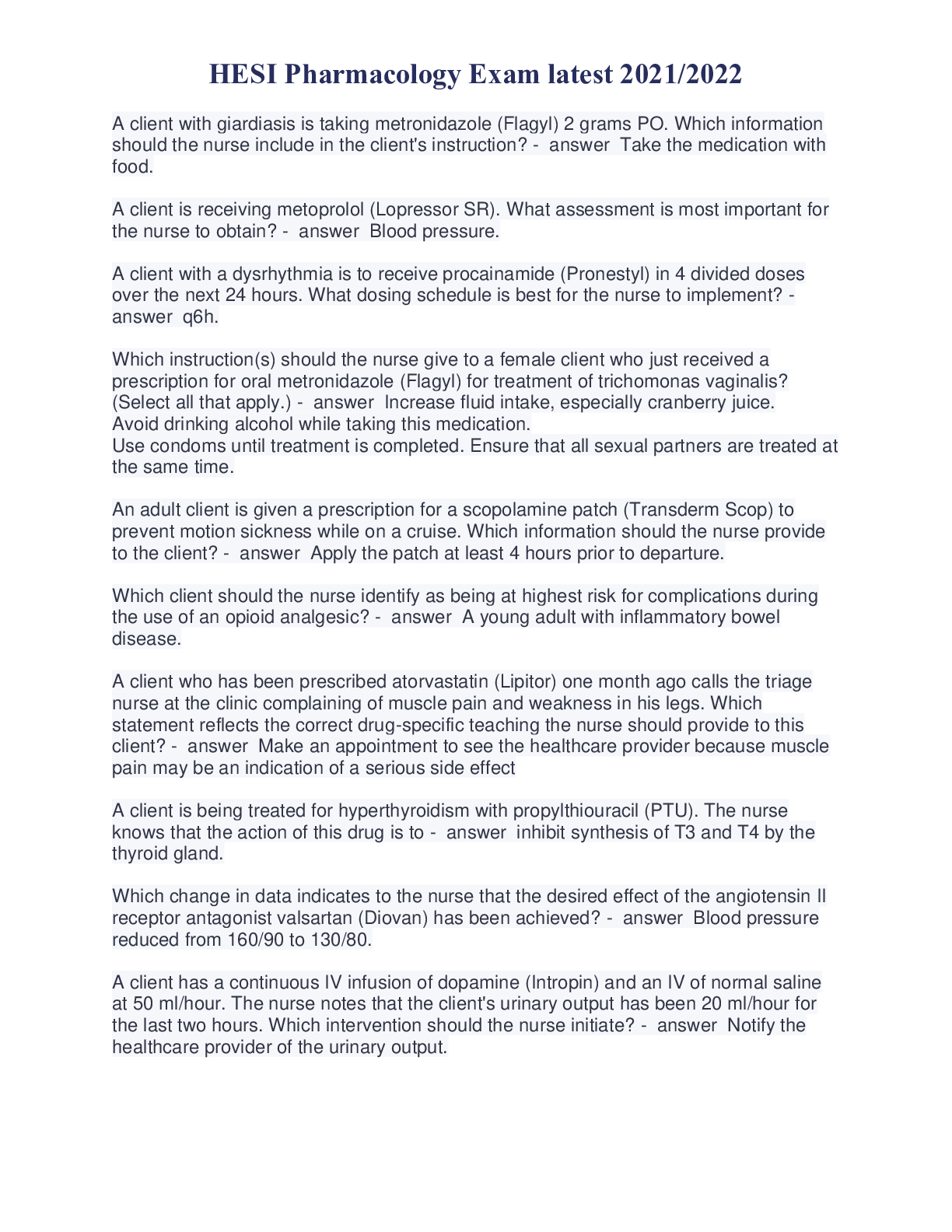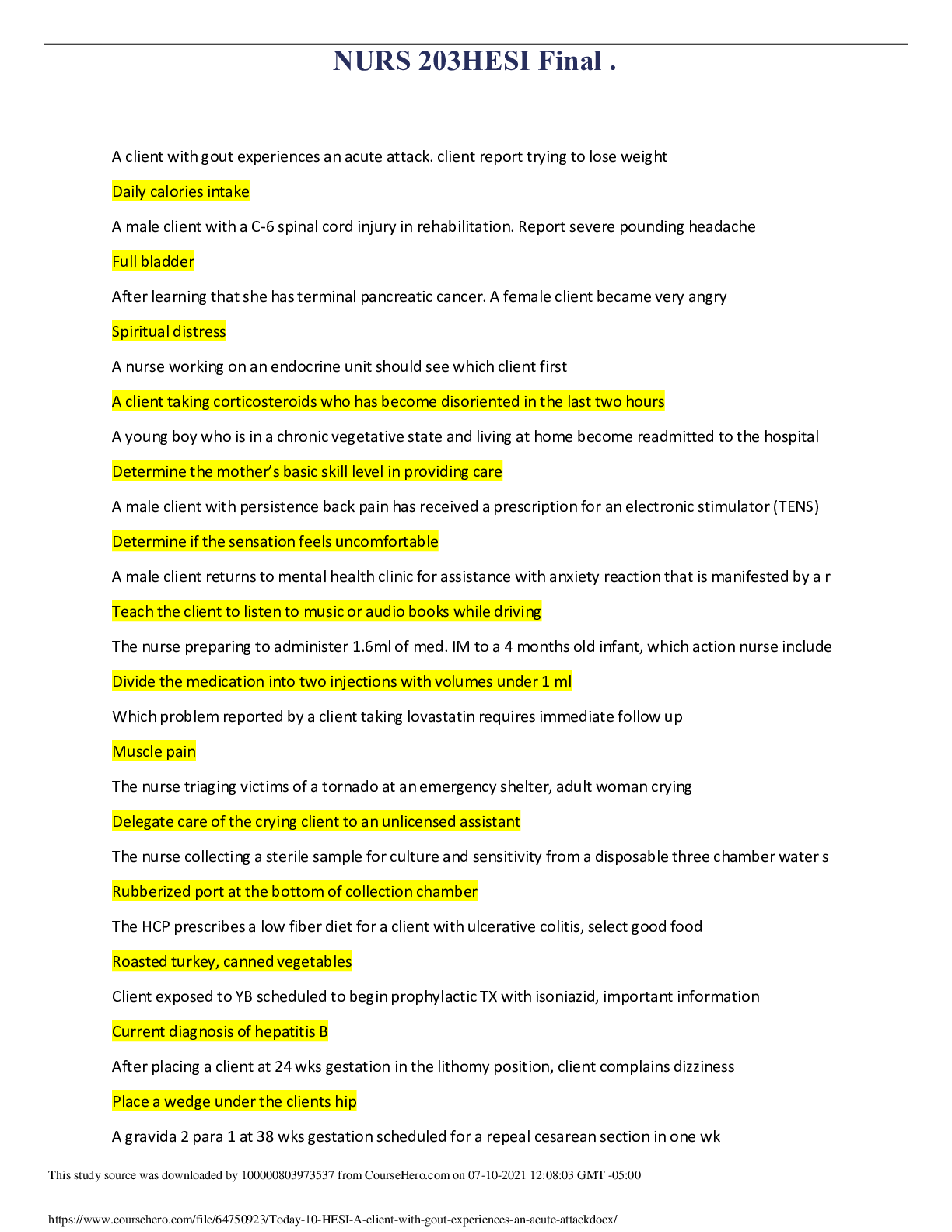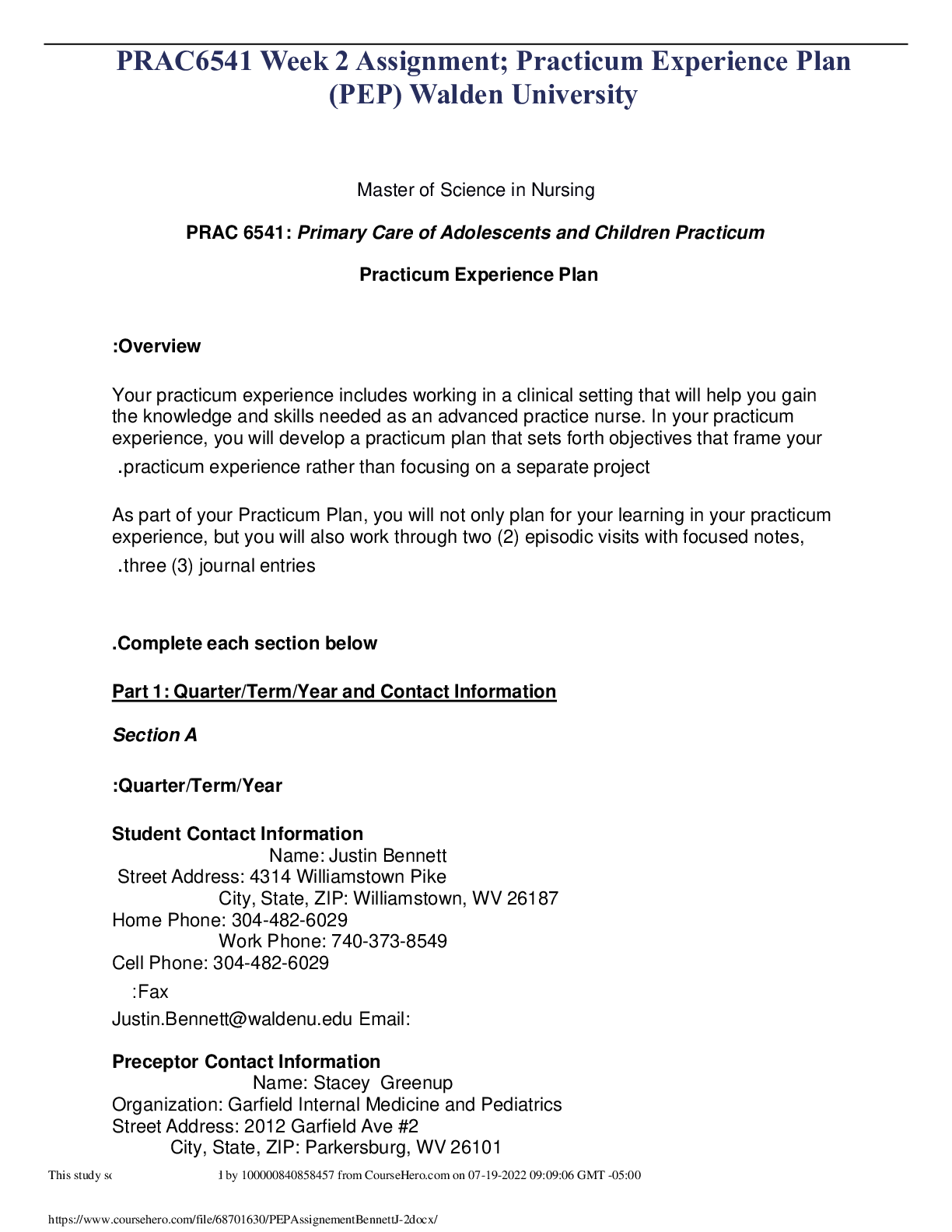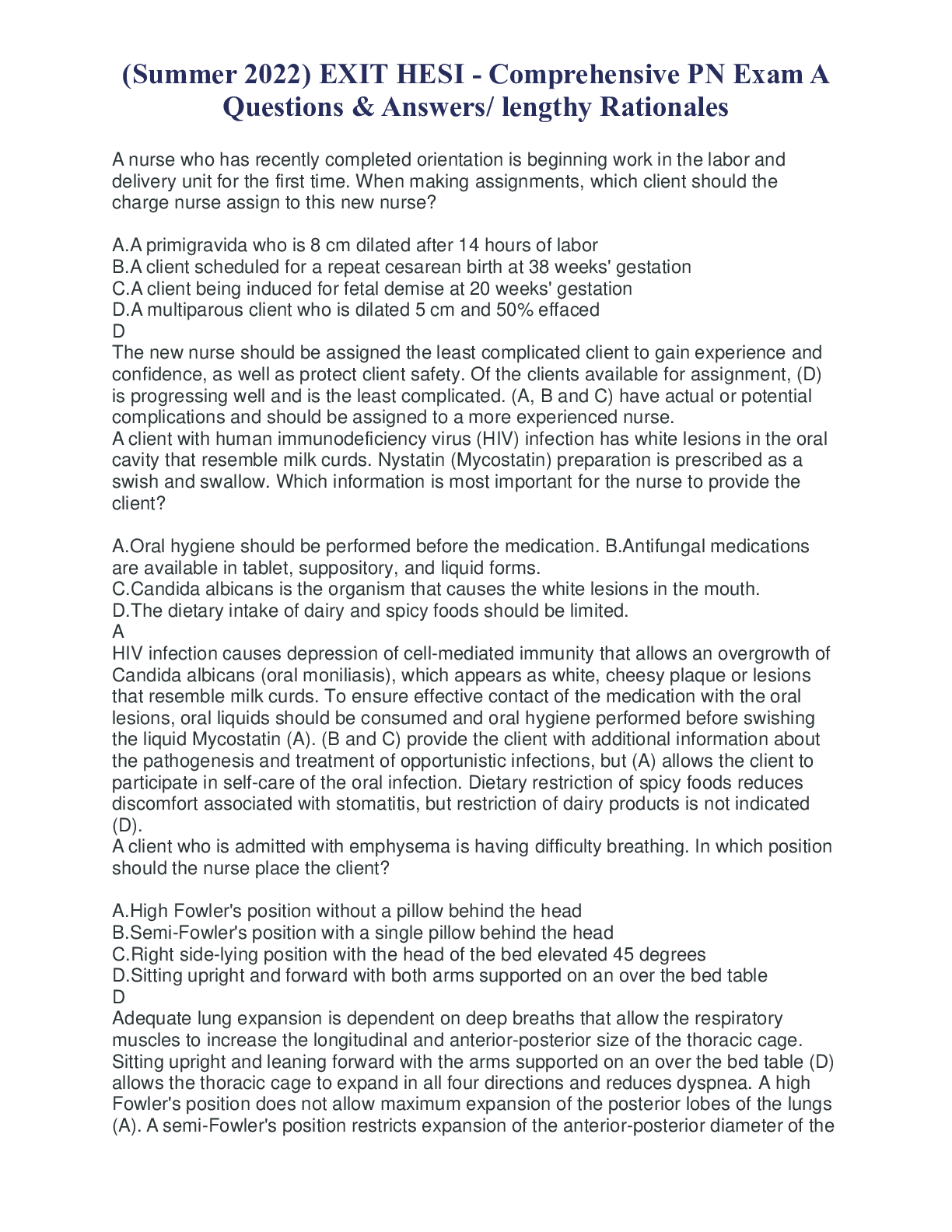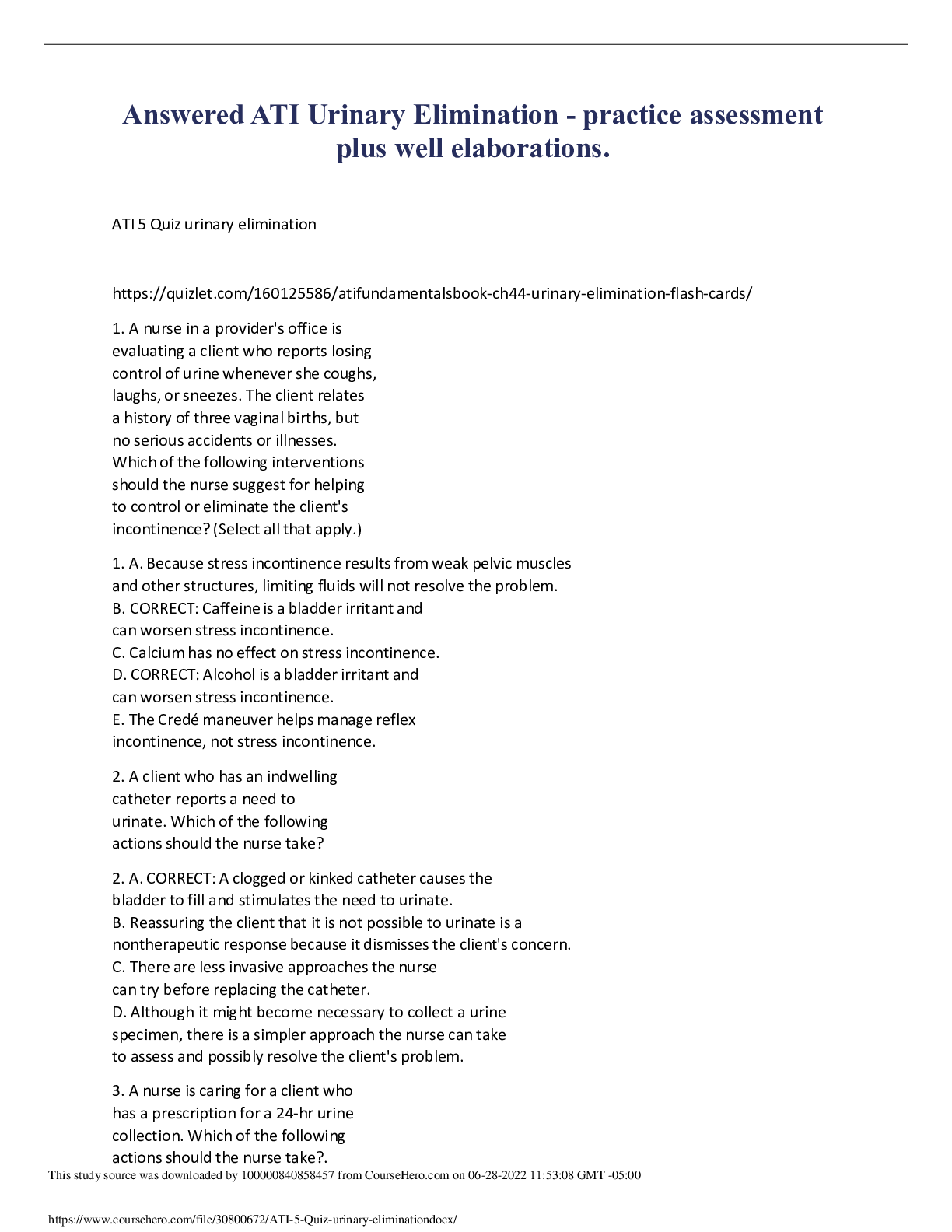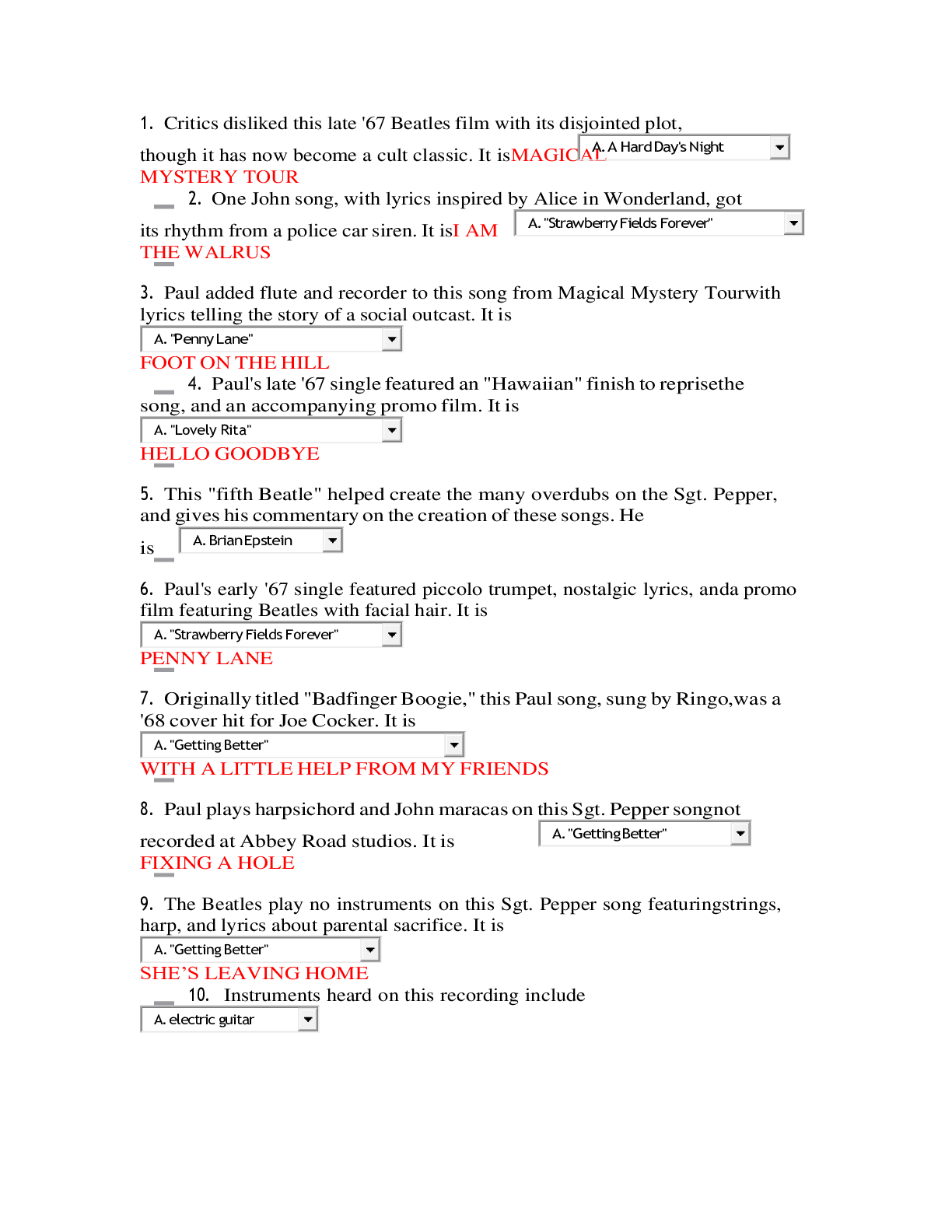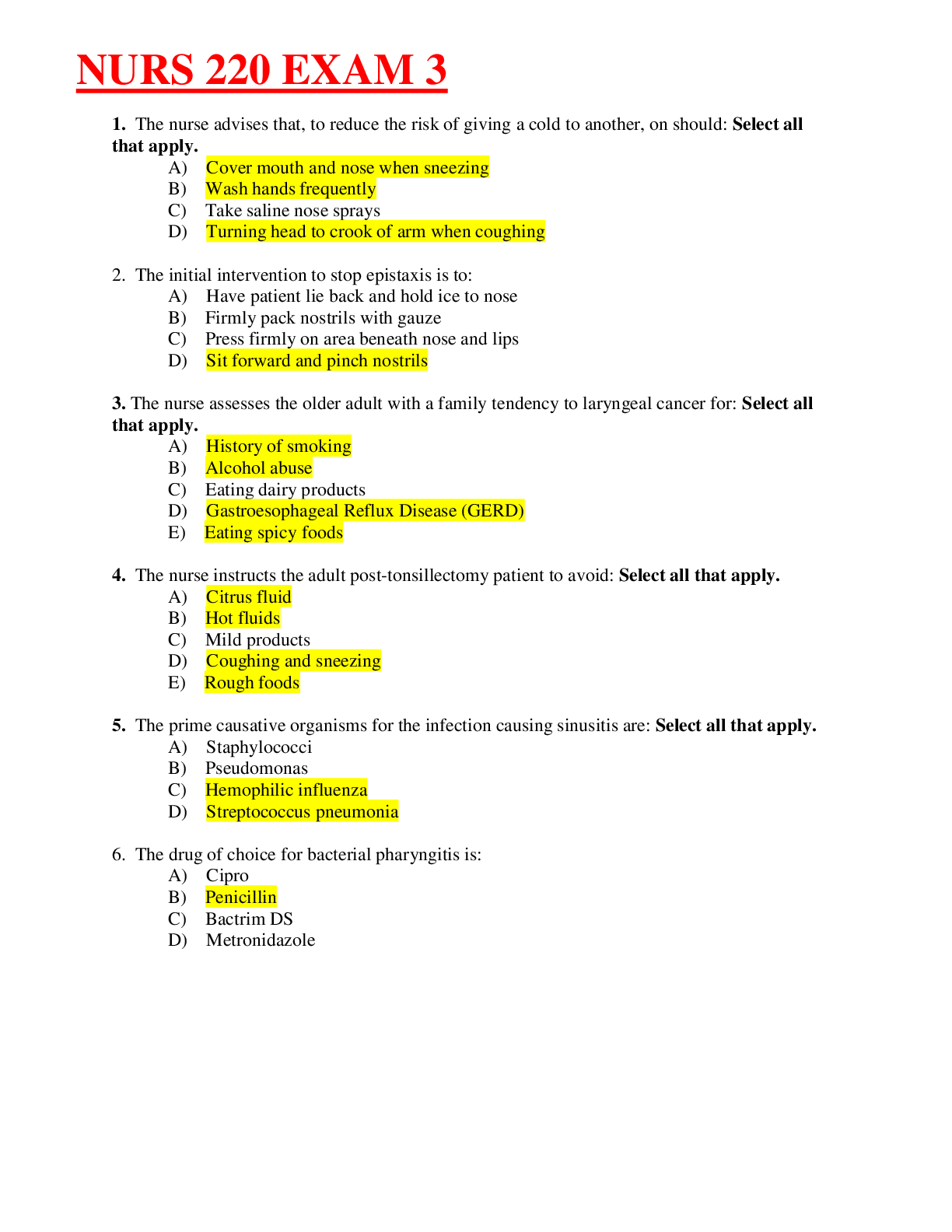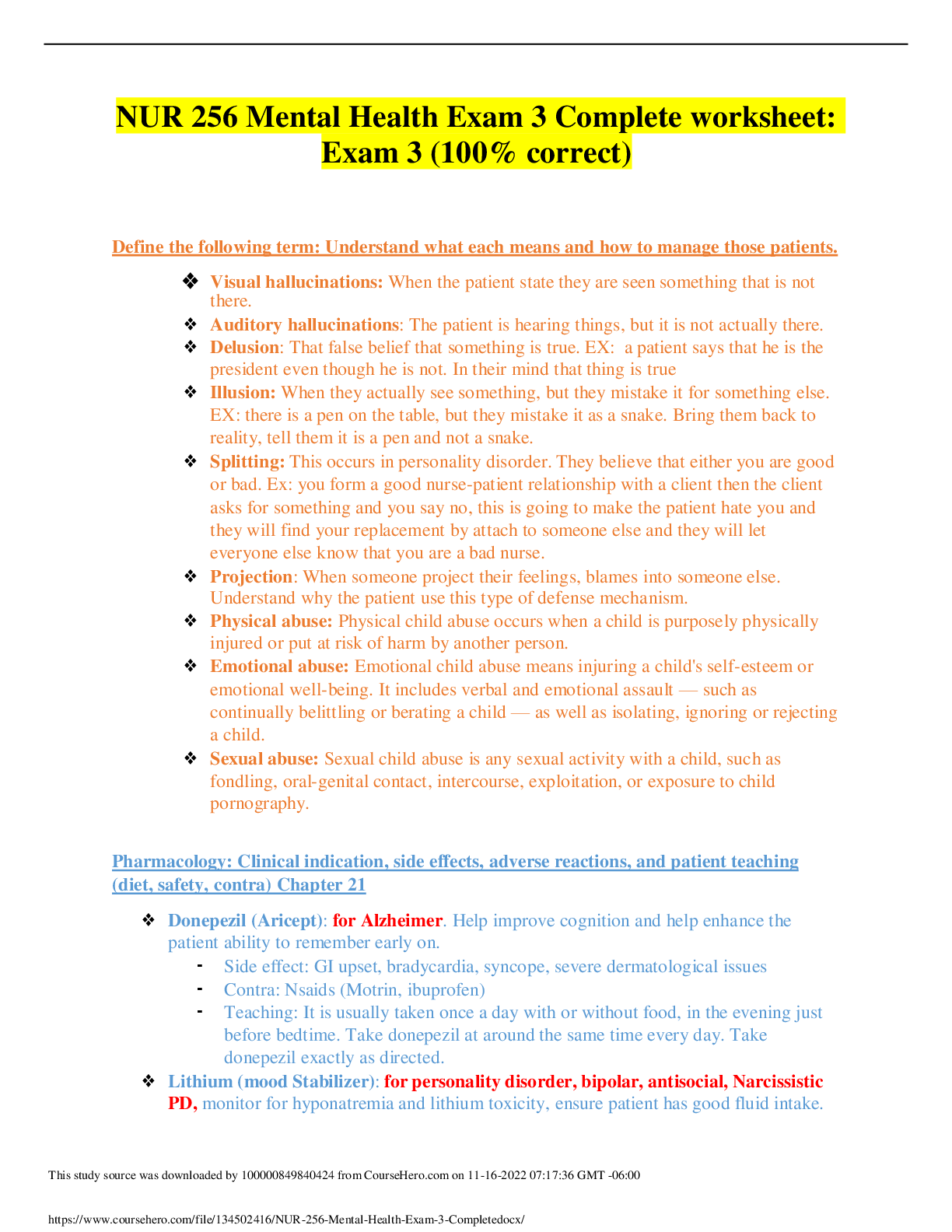*NURSING > EXAM > Summary Eastern Florida State College; NURC1143/ NURC 1143 Exam 3 Complete Study Guide. (All)
Summary Eastern Florida State College; NURC1143/ NURC 1143 Exam 3 Complete Study Guide.
Document Content and Description Below
1 Medication administration-Eye Mydriatics (apraclonidine/Iopidine) - Dilate the pupil Reduces IOP 23-39% by stimulating alpha2 & beta2 receptors Prevents ocular vasoconstriction-reduces o... cular bp as well as aqueous humor formation Used to inhibit perioperative IOP increases rather than treat glaucoma Burning, eye pain, lacrimation, rare systemic effects: HTN, tachycardia, extrasystoles Miotics (acetylcholine, pilocarpine)- Constrict the pupil Cycloplegics (atropine, cyclopentolate) -Paralyze the ciliary body; Have mydriatic properties Cycloplegia: paralysis of accommodation Nursing implications Assess patient’s history including meds Assess baseline vitals, visual acuity & do physical assessment of eye & surrounding structures Assess for contraindications to specific drugs Avoid touching eye w/tip of dropper; Apply ointments as a thin layer in the conjunctival sac Pressure may be applied to inner canthus for 1 minute to reduce systemic absorption of drug Cholinergic Drugs Mimic the parasympathetic NS neurotransmitter acetylcholine; Also called miotics, cholinergics Direct-acting - Acetylcholine (Miochol-E) - Used to produce miosis during ophthalmic surgery Indirect-acting drugs-Echothiophate (Phospholine iodide) Cause pupillary constriction (miosis), which leads to reduced IOP caused by increased outflow of aqueous humor Indications: open-angle glaucoma, angle-closure glaucoma, convergent strabismus (cross-eye), ophthalmologic exams Adverse effects - Most limited to local effects; If sufficient amounts enter the bloodstream, systemic effect may occur (most likely w/indirect-acting agents): o Hypotension, bradycardia/tachycardia, Headache, NVD, abdominal cramps, asthma attacks Chapter 58: Otic Drugs Medication Administration EAR (2 Q) 1. (Adult) Pull pinna up and back; (Child less than 3) Pull pinna down and back. 2. Allow time for eardrops to flow down into canal. 2. Have the patient lie on side opposite to ear infection for about 5 minutes after instilling. 2. A small cotton ball may be gently placed into ear canal to keep drug in, do not force cotton into ear canal 2. Gently massage tragus of ear to encourage flow of medication. Chapter 57: Opthalmic Drugs - Glaucoma (2 Q) Glaucoma: elevated pressure w/in eye from obstruction of outflow of aqueous humor. Pressure against the retina destroys neurons, leading to impaired vision &2 eventual blindness. Inhibition of normal flow. Results in increased intraocular pressure (IOP). Damages optic nerve. o Pressure against the retina destroys neurons, leading to impaired vision & eventual blindness. Angle closure glaucoma can cause rapid vision loss, less common; Open-angle glaucoma chronic, more common Also characterized by underlying cause-Primary, Secondary, Congenital Chapter 57: Opthalmic Drugs - Cholinergic (1 Q) Cholinergic Drugs (miotics) are used to treat glaucoma. o Cholinergic drugs mimic the effect of acetylcholine (neurotransmitter). o Direct-acting and indirect-acting drugs o Cause pupillary constriction (miosis), which leads to reduced IOP caused by increased outflow of aqueous humor MEDS TO KNOW o Pilocarpine: direct-acting cholinergic. Miotic for chronic open-angle & angleclosure glaucoma. (Ocusert Pilo-20): applied once weekly by the patient o Timolol: differs slightly from other ophthalmic beta blockers in that it reduces IOP by increasing the outflow of aqueous humor as well as decreases its formation. It does NOT affect pupil size, accommodation, or night vision o Latanoprost: naturally occurring prostaglandin. Converted by hydrolysis (w/ water from ocular fluids) to prostaglandin F2-alpha, which in turn reduces IOP. Most drugs allow for single daily dosing because of effects lasting for 20 to 24 hours. In some persons with hazel, green, or blue/brown eyes, eye color will change permanently to brown. Color change occurs even if the medication is stopped. Chapter 58: Otic Drugs - Otitis Media (1Q) Common disease of infancy & early childhood; Often preceded by upper respiratory tract infection. Trauma to tympanic membrane can cause otitis media in adults. Symptoms - pain, fever, malaise, pressure, sensation of fullness in the ears, or hearing loss. If untreated, tinnitus, nausea, vertigo, or mastoiditis may occur. Hearing deficits and hearing loss may result if prompt therapy is not started. Chapter 56: Dermatologic Drugs Medication Dermatologic (5Q) Bacterial, fungal, and viral drugs. Oil based medications make them stickier than creams and better for smaller areas. Creams are water based and are better for larger surfaces; Gels enhance penetration of active ingredient. Lotions are like creams but are lighter; Powder promotes drying of area where applied MEDS TO KNOW3 o Mupirocin: (Topical/ intranasal antibacterial). Used topically for Staph & Strep impetigo Applied topically tid & intranasally bid to treat MRSA. o Silver sulfadiazine: (Topical anti-infective). To prevent/treat infection for 2nd & 3rd degree burns. Adverse effects= pain, burning, itching. Do not use in patients who are allergic to sulfonamide drugs. o Clotrimazole: (topical antifungal) used to treat oropharyngeal candidiasis (thrush) & dermatophytosis (athlete’s foot). o Lindane: (topical scabicide & pediculicide) used for scabies, lice, nits. For those intolerant to or who do not respond to other agents. Topical; Does not prevent from getting lice/mites. o Isotretinoin: (antiacne) Oral product. Treats severe resistant cystic acne. Inhibits sebaceous gland activity & has anti-skin hardening & antiinflammatory effects. Pregnancy category X drugs. Female patients must be counseled & agree not to become pregnant during use Chapter 24: Heart Failure - Action, Nursing Implications and Antidotes for Digoxin (3Q) o Digoxin: indicated for the treatment of heart failure, atrial fib & flutter. Oral and injectable. o Contraindicated-known hypersensitivity & w/ vent. tachycardia & fibrillation. o Normal therapeutic drug levels are b/w 0.5 and 2ng/mL o Levels higher than 2ng/mL are used for the treatment of atrial fibrillation. o Because of Digoxin’s long half-life, a loading “digitalizing” dose is often given to bring serum levels of the drug up to desirable therapeutic level more quickly. o Asses apical pulse for 1 minute before giving product/ If pulse is less than 60 in adult or 90 in infant call prescriber. Monitor ECG continuously during parenteral loading dose. Monitor I and O’s, daily weight, check for edema. Monitor for increase/decrease in potassium. o Low potassium can increase chance for digoxin toxicity. Antidote: Digoxin immune Fab (Digifab). For reversal of life-threatening cardiotoxic effects. Only in parenteral form. Chapter 24: Heart Failure - Milrinone Adverse Effects (1Q) Adverse Effects: (inotropic, vasodiolator); Cardiac dysrhythmias, headache, hypokalemia, tremor, thrombocytopenia, and elevated liver enzyme levels. Chapter 24: Heart Failure - Drugs of Choice for Early Treatment of Heart Failure (1Q) Focus on reducing effects of the renin-angiotensin-aldosterone system & sympathetic nervous system o ACE inhibitors (lisinopril, enalapril, captopril, and others) o ARBs (valsartan, candesartan, losartan, and others) o Certain beta-blockers (metoprolol, a cardioselective beta-blocker; carvedilol, a nonspecific beta-blocker) o Loop diuretics (furosemide) used to reduce the symptoms of HF secondary to fluid overload. o Aldosterone inhibitors (spironolactone, eplerenone) are added as the HF progresses.4 o Only after these drugs are used is digoxin added. o Dobutamine: positive inotropic drug o Hydralazine/isosorbide dinitrate (BiDil) was 1st drug approved specifically for use in the African-American population. WATCH THIS Chapter 25: Antidysrhythmic Drugs - Adenosine (Adenocard) (1Q) Adenosine (Adenocard) o Slows electrical conduction time thru AV node; indicated for the conversion of PSVT (Paroxysmal supraventricular tachycardia) to sinus rhythm. o It is useful when the PSVT has failed to respond to verapamil or if patient has coexisting conditions such as heart failure, hypotension, or left ventricular dysfunction that limit use of verapamil. o Very short half-life—less than 10 seconds; Only administered as fast intravenous (IV) push o May cause asystole for a few seconds Chapter 25: Antidysrhythmic Drugs - Cardizem (1Q) Diltiazem (Cardizem) o Temporary control of a rapid ventricular response in pts w/ AFib or flutter & PSVT o Very effective for treatment of angina pectoris from coronary insufficiency & hypertension o Contraindications: hypersensitivity, acute myocardial infarction, pulmonary congestion, Wolff-Parkinson-White syndrome, severe hypotension, cardiogenic shock, sick sinus syndrome, or second- or third-degree AV block Chapter 25: Antidysrhythmic Drugs - Adverse Effects (1Q) Antidysrhythmics: Adverse Effects; ALL antidysrhythmics can cause dysrhythmias! o Hypersensitivity reactions, Nausea, vomiting, and diarrhea, Dizziness, Headache and blurred vision, Prolongation of the QT interval Chapter 25: Antidysrhythmic Drugs - Admiodarone (Cordarone) (1Q) Amiodarone (Cordarone, Pacerone); Class III Antiarrhythmic o Markedly prolongs the action potential duration & effective refractory period in all cardiac tissues o Blocks both alpha- & beta-adrenergic receptors of the sympathetic nervous system Uses: one of the most effective antidysrhythmic drugs for controlling supraventricular and ventricular dysrhythmias Indications: management of sustained ventricular tachycardia, ventricular fibrillation, and nonsustained ventricular tachycardia Drug of choice for ventricular dysrhythmias according to the Advanced Cardiac Life Support guidelines Adverse effects: corneal microdeposits (may cause visual halos), photophobia, dry eyes, photosensitivity; pulmonary toxicity Drug interactions: digoxin and warfarin; Contraindications: hypersensitivity, severe sinus bradycardia or second- or third-degree heart block Chapter 28: Diuretic Drug Spironolactone (1Q) Spironolactone (Aldactone): potassium-sparing diuretic & aldosterone antagonistreduces symptoms of HF5 o Hyperaldosteronism; Hypertension; Reversing potassium loss caused by potassium-losing drugs o Certain cases of HF: prevention of remodeling Adverse effects - Gynecomastia, amenorrhea, irregular menses, postmenopausal bleeding, Dizziness, headache, cramps, NVD, frequent urination, weakness & hyperkalemia (high K+) Interactions: Lithium, ACE inhibitors, Potassium supplements, NSAIDs Chapter 28: Diuretic Drug Nursing Implications (2Q) Nursing Implications Perform a thorough patient history & physical examination. Assess baseline fluid volume status, Is & Os, serum electrolytes, weight & vital signs (esp. postural BP) Assess for disorders that may contraindicate/necessitate cautious use of these drugs. Instruct patients to take the med in the morning if possible to avoid interference w/ sleep patterns. Monitor serum potassium levels during therapy Teach patients to maintain proper nutritional and fluid volume status. Teach patients to eat more potassium-rich foods when taking any, but the potassium-sparing drugs. o Foods high in potassium include bananas, oranges, dates, apricots, raisins, broccoli, green beans, potatoes, meats, fish, and legumes. Patients taking diuretics w/ a digitalis preparation should be taught to monitor for digitalis toxicity. Patients w/ diabetes mellitus who are taking thiazide or loop diuretics should be told to monitor blood glucose & watch for elevated levels. Teach patients to change positions slowly & rise slowly after sitting/lying to prevent dizziness & fainting= orthostatic hypotension. Encourage patients to keep a log of their daily weight. Patients ill w/ NVD should notify their primary care providers-fluid and electrolyte imbalances can result. S&S of hypokalemia include muscle weakness, constipation, irregular pulse rate & lethargy. Instruct patients to notify their primary care providers immediately if they experience rapid heart rates or syncope (reflects hypotension or fluid loss). Excessive consumption of licorice can lead to additive hypokalemia in patients taking thiazides. Monitor for adverse effects: o Metabolic alkalosis, drowsiness, lethargy, hypokalemia, tachycardia, hypotension, leg cramps, restlessness, decreased mental alertness Monitor for hyperkalemia with potassium-sparing diuretics. Monitor for therapeutic effects: Reduction of edema; Reduction of fluid volume overload; Improvement in manifestations of HF; Reduction of hypertension; Return to normal intraocular pressures Chapter 28: Diuretic Drug Mannitol (Osmitrol) (1Q) Most used osmotic diuretic; Intravenous (IV) infusion only w/ filter - May crystallize in bag/tubes when exposed to low temperatures6 Indications: Treatment of patients in early, oliguric phase of acute renal failure (ARF) (IRF) o Acute renal failure CAN be reversed o To promote excretion of toxic substances; To reduce intracranial pressure; Treatment of cerebral edema (Mannitol) Adverse Effects: Convulsions, Thrombophlebitis, Pulmonary congestion Chapter 29: Fluids and Electrolytes - Blood Products (1Q) Blood Products: Indications o Cryoprecipitate and plasma protein factors Management of acute bleeding (greater than 50% slow blood loss or 20% acutely) o Fresh-frozen plasma (FFP)-Increase clotting factor levels in patients with demonstrated deficiency o Packed red blood cells (PRBCs) -To increase oxygen-carrying capacity in patients w/ anemia, in patients w/ substantial hemoglobin deficits, & in patients who have lost up to 25% of their total blood volume o Whole blood Same as for PRBCs except that whole blood is more beneficial in cases of extreme (greater than 25%) loss of blood volume because whole blood also contains plasma Contains plasma proteins, which help draw fluid back into blood vessels from surrounding tissues Chapter 29: Fluids and Electrolytes - Nursing Considerations for Potassium Administration (1Q) Nursing Implications o Assess baseline fluid volume, electrolyte status & vital signs. o Assess skin, mucous membranes, daily weights, and input and output. o Before giving potassium, assess electrocardiogram. o Assess for contraindications to therapy & transfusion history. o Establish venous access as needed. o Monitor serum electrolyte levels, infusion rate, appearance of fluid/solution & infusion site. o Observe for infiltration and other complications of IV therapy. Parenteral infusions of potassium must be monitored closely. IV potassium must not be given at a rate faster than 10 mEq/hr to patients who are not on cardiac monitors. For critically ill patients on cardiac monitors, rates of 20 mEq/hr or more may be used. NEVER give as an IV bolus or undiluted Oral forms of potassium Must be diluted in water or fruit juice to minimize GI distress or irritation Monitor for complaints of nausea, vomiting, GI pain, and GI bleeding Chapter 22: Antihypertensive Drugs - Nursing Implications (2Q) Nursing Implications o Before beginning therapy, obtain a thorough health history & head-to-toe physical exam.7 o Assess for contraindications to specific antihypertensive drugs & conditions that require cautious use of these drugs. o Instruct patients to check w/ their physicians for instructions on what to do if a dose is missed; patients should never double up on doses if a dose is missed o Monitor BP during therapy; instruct patients to keep a journal of regular BP checks. o Instruct patients that these drugs should not be stopped abruptly because this may cause a rebound hypertensive crisis and perhaps lead to stroke. o Oral forms should be given with meals so that absorption is more gradual and effective. o Administer IV forms with extreme caution and use an IV pump. o Remind patients that medication is only part of therapy. Encourage patients to watch their diet, stress level, weight, and alcohol intake. o Instruct patients to avoid smoking and eating foods high in sodium. Encourage supervised exercise. o Teach patients to change positions slowly to avoid syncope from postural hypotension. o Instruct patients to report unusual shortness of breath; difficulty breathing; swelling of the feet, ankles, face, or around the eyes; weight gain or loss; chest pain; palpitations; and excessive fatigue. o Male patients who take these drugs may not be aware that impotence is an expected effect, and this may influence compliance with drug therapy. o Hot tubs, showers, or baths; hot weather; prolonged sitting or standing; physical exercise; and alcohol ingestion may aggravate low BP, leading to fainting and injury; patients should sit or lie down until symptoms subside. o Patients should not take any other medications, including OTCs, w/o approval of their DR. o Weight loss, Stress management, Supervised exercise, Dietary measures o Monitor for adverse effects (dizziness, orthostatic hypotension, fatigue) and for toxic effects. o Monitor for therapeutic effects. Chapter 22: Antihypertensive Drugs - ACE Inhibitors Indications (Captopril and Lisinopril) (1Q) Indications o Hypertension and HF (either alone or in combination with diuretics or other drugs) o Slow progression of left ventricular hypertrophy after myocardial infarction (MI)(cardioprotective) o Renal protective effects in patients w/ diabetes o Captopril and lisinopril are NOT prodrugs & can be used if patient has liver dysfunction, unlike other ACE inhibitors that are prodrugs o Prodrugs are inactive in their administered form & must be metabolized in the liver to an active form so as to be effective. Chapter 22: Antihypertensive Drugs - ACE Inhibitors Adverse Effects (2Q) ACE Inhibitors: Adverse Effects: Fatigue, Dizziness, Headache, Mood changes, Impaired taste, Possible hyperkalemia, Dry, nonproductive cough, which reverses when therapy is stopped8 o Angioedema: rare but potentially fatal; Note: First-dose hypotensive effect may occur. Chapter 23: Antiangina; Drugs - Nursing Implications for Nitoglycerin/ Contradincations for CCBs (3Q) Nitrates: long been the mainstay for prophylaxis & Tx for angina & other cardiac problems. Today there are several chemical derivatives of the early precursors, all of which are organic nitrate esters -available in a wide variety of preparations, including sublingual & oral tablets; capsules; ointments; patches; a translingual spray & IV solutions. Nitroglycerin (both rapid and long acting); Routes- PO, SL, IV, metered dose aerosol (SL); topical Contraindications to the use of nitrates include known drug allergy, severe anemia, closed-angle glaucoma, hypotension, severe head injury o Nitrates are also contraindicated w/ erectile dysfunction drugs sildenafil (Viagra), tadalafil (Cialis), and vardenafil (Levitra) o Side Effects: Headache, which generally diminishes soon after the start of therapy, Tachycardia, Postural hypotension; If nitrate-induced vasodilation occurs too rapidly, the cardiovascular system over-compensates and increases the heart rate, a condition referred to as reflex tachycardia. o Nursing Implications Cause vasodilation because of relaxation of smooth muscles Potent dilating effect on coronary arteries; Result: oxygen to ischemic myocardial tissue Used for prevention and treatment of angina IV forms of nitroglycerin must be given with special non-PVC tubing and bags. Discard parenteral solution that is blue, green, or dark red. When given orally- nitroglycerin goes to the liver to be metabolized before it can become active in the body. Sublingual Tablets are used for the treatment of chest pain/angina) of acute onset. Also used for prevention of angina when patients find themselves in situations likely to provoke an attack. IV form- used for BP control in perioperative hypertension, treatment of heart failure (HF), ischemic pain, pulmonary edema associated with acute MI, and hypertensive emergencies. Most important drug used for symptomatic Tx of ischemic heart conditions (angina) Calcium Channel Blockers Indications 1. Cause coronary & peripheral artery vasodilation, thus decreasing systemic vascular resistance 2. Reduce the workload of the heart; Result: decreased myocardial oxygen demand 3. Dysrhythmias: depression of the automaticity of & conduction thru the SA & AV nodes Calcium Channel Blockers Contradictions- Known drug allergy; Acute MI, Second- or third-degree AV block (unless the patient has a pacemaker), Hypotension Chapter 23: Antiangina; Drugs - Beta Blockers Systems Adverse Effects (1Q)9 Indications for Beta Blockers – Angina, Antihypertensive, Cardiac dysrhythmias, Cardioprotective effects, especially after MI; Some used for migraine headaches, essential tremors, and stage fright 1. Common Side Effects – Bradycardia, Hypotension, AV block, Hyper-/Hypoglycemia, Hyperlipidemia (high levels of fat), Dizziness, Fatigue, Depression, Lethargy, Impotence, Wheezing, Dyspnea Chapter 23: Coagulation Modifier Drugs - Warfarin Toxicity (1Q) Treatment: Toxic Effects of Warfarin - Discontinue the warfarin. o May take 36-42 hrs before the liver can resynthesize enough clotting factors to reverse the warfarin effects o Vitamin K1 (phytonadione) can hasten the return to normal coagulation. o High doses of vitamin K (10 mg) given IV will reverse the anticoagulation within 6 hours. o Caution: when vitamin K is given, warfarin resistance will occur for up to 7 days. o Severe bleeding: transfusions of human plasma or clotting factor concentrates. o Life-threatening bleeding from warfarin: Kcentra and Profiline o IV vitamin K: risk of anaphylaxis. Risk is diminished by diluting it and giving it over 30 minutes. Chapter 23: Coagulation Modifier Drugs - Heparin (2Q) Natural anticoagulant obtained from the lungs or intestinal mucosa of pigs 10 to 40,000 units/mL DVT prophylaxis: 5000 units subQ 2-3x/day; does not need to be monitored when used for prophylaxis When heparin is used therapeutically (for treatment), continuous IV infusion. Measurement of aPTT (usually every 6 hours until therapeutic effects are seen) is necessary o Heparins—part 1: Action: inhibit clotting factors IIa (thrombin) and Xa Unfractionated heparin: “heparin” Low–molecular-weight heparins (LMWHs) Enoxaparin (Lovenox) Dalteparin (Fragmin) Synthetic smaller molecular structure More predictable anticoagulant response Frequent laboratory monitoring of bleeding times using tests such as aPTT not needed o Heparins—part 2 Unfractionated heparin (heparin) Relatively large molecule that is derived from animal sources Frequent laboratory monitoring for bleeding times such as aPTT Heparin for catheter flush (10 to 100 units/mL): no monitoring is needed o Anticoagulants: Indications Used to prevent clot formation in certain settings in which clot formation is likely10 MI, Unstable angina, AFib, Indwelling devices, such as mechanical heart valves, Major orthopedic surgery o Anticoagulants: Contraindications Drug allergy Any acute bleeding process or high risk for such an occurrence. Warfarin is strongly contraindicated in pregnancy; Other anticoagulants are rated in lower pregnancy categories (B or C). LMWHs are contraindicated in patients w/ indwelling epidural catheter risk of epidural hematoma. o Anticoagulants: Adverse Effects Bleeding: Risk increases with increased dosages; May be localized or systemic May cause Heparin-induced thrombocytopenia, NV, abdominal cramps, thrombocytopenia o Heparin-Induced Thrombocytopenia Type I: Gradual reduction in platelets; Heparin therapy can generally be continued. Type II: Acute fall in the number of platelets (more than 50% reduction from baseline) Discontinue heparin. Clinical manifestations: Thrombosis that can be fatal Treatment: thrombin inhibitors lepirudin and argatroban Use of warfarin: can cause skin necrosis and “purple toes” syndrome o Treatment: Toxic Effects of Heparin Symptoms: hematuria, melena (blood in the stool), petechiae, ecchymoses, and gum or mucous membrane bleeding Stop drug immediately. IV protamine sulfate: 1 mg can reverse the effects of 100 units of heparin. o Nursing Implications 1. IV doses are usually double checked w/ another nurse. 2. Ensure that subQ doses are given subcutaneously, not intramuscularly, and given in areas of deep subcutaneous fat & sites rotated. 3. Do not give subcutaneous doses within 2 inches of: The umbilicus, abdominal incisions, open wounds, scars, drainage tubes, or stomas 4. Do not aspirate subcutaneous injections or massage the injection site 5. May cause hematoma formation 6. IV doses may be given by bolus or IV infusions. 7. Anticoagulant effects are seen immediately. 8. Laboratory values are done daily to monitor coagulation effects. 9. Protamine sulfate can be given as an antidote in case of excessive anticoagulation. Chapter 23: Coagulation Modifier Drugs - Warfarin (Coumadin) (1Q) Most commonly prescribed oral anticoagulant. Careful monitoring of the prothrombin time/international normalized ratio (PT/INR)11 A normal INR (without warfarin) is 1.0, but a therapeutic INR (w/ warfarin) ranges from 2 to 3.5, depending on the indication for use of the drug (e.g., atrial fibrillation, thromboprevention, prosthetic heart valve). o Warfarin: Inhibits vitamin K synthesis by bacteria in the GI tract, production of vitamin K–dependent clotting factors II, VII, IX, and X, which are normally synthesized in the liver 1. Final effect prevention of clot formation o Nursing Implications 1. May be started while the patient is still on heparin until PT/INR levels indicate adequate anticoagulation 2. Full therapeutic effect takes several days. 3. Monitor PT/INR regularly; keep follow-up appointments. 4. Antidote is vitamin K. o Many herbal products have potential interactions; increased bleeding may occur with Capsicum pepper, garlic, ginger, ginko, St. John’s wort, feverfew Rout e Onset of Action Peak Plasma Concentration Elimination Half-Life Duration of Action PO 24-72 hr 4 hr 0.5 – 3 days 2 – 5 days Chapter 27: Antilipemic Drugs - Niacin (1Q): Vitamin B3, niotinic acid Lipid-lowering properties require much higher doses than when used as a vitamin Effective, inexpensive, often used in combination with other lipid-lowering drugs Niacin: Mechanism of Action o Thought to increase activity of lipase, which breaks down lipids o Reduces the metabolism or catabolism of cholesterol and triglycerides Niacin: Indications o Effective in lowering triglyceride, total serum cholesterol, and LDL levels; Increases HDL levels o Effective in the treatment of types IIa, IIb, III, IV, and V hyperlipidemias Niacin: Adverse Effects: Pruritis, GI distress o Flushing (caused by histamine release) Small dose aspirin or NSAIDS 30 minutes before Niacin may help cutaneous flushing To minimize adverse effects of niacin, start on low initial dose and gradually increase it, and take with meals Nursing Implications o Thought to increase activity of lipase, which breaks down lipids o Reduces the metabolism or catabolism of cholesterol and triglycerides Chapter 23: Antilipemic Drugs - Nursing Implications (2Q) Nursing Implications o Before beginning therapy, obtain a thorough health and medication history. o Assess dietary patterns, exercise level, weight, height, vital signs, tobacco and alcohol use, and family history.12 o Assess for contraindications, conditions that require cautious use, and drug interactions. Contraindications include biliary obstruction, liver dysfunction, and active liver disease. o Obtain baseline liver function studies. Patients on long-term therapy may need supplemental fat-soluble vitamins (A, D, K). Counsel patient concerning diet and nutrition on an ongoing basis & proper procedure for taking the meds Powder forms must be taken w/ a liquid, mixed thoroughly but not stirred & never taken dry. Other meds should be taken 1 hour before or 4-6 hours after meals to avoid interference w/ absorption. To minimize adverse effects of niacin, start on low initial dose & gradually increase it & take with meals. o Small doses of aspirin or NSAIDs may be taken 30 minutes before niacin to minimize cutaneous flushing. Provide teaching regarding use of NSAIDs and aspirin. o Inform patients that these drugs may take several weeks to show effectiveness. o Instruct patients to report persistent GI upset, constipation, abnormal or unusual bleeding, and yellow discoloration of the skin. o Monitor for adverse effects, including increased liver enzyme studies. o Monitor for therapeutic effects: Reduced cholesterol and triglyceride levels Chapter 23: Antilipemic Drugs - Garlic (1Q) Herbal Product: Garlic Used as: Antispasmodic, Antihypertensive, Antiplatelet, Lipid reducer o Adverse effects: Dermatitis, Vomiting, Diarrhea, Flatulence, Antiplatelet activity o Possible interactions with: Warfarin, Diazepam, May enhance bleeding when taken w/NSAIDs EVOLVE NCLEX QUESTIONS CHAPTER 22 ANTIHYPERTENSIVE DRUGS The nurse is assessing the patient's knowledge regarding drug therapy prescribed for the treatment of hypertension. Which statement by the patient indicates the need for further teaching by the nurse? "When my blood pressure is over 140/90, I will take my medication." Patients must adhere to prescribed antihypertensive regimen to prevent end-organ damage. Many patients do not adhere to this regimen because hypertension itself does not cause symptoms, but the medication may produce unwanted adverse effects. Patient teaching is essential. The nurse understands a patient who is treated for hypertension may be switched to an angiotensin receptor blocker (ARB) because of which angiotensin-converting enzyme (ACE) inhibitor adverse effect? Dry, nonproductive cough ACE inhibitors13 block the breakdown of bradykinins and may cause a dry, nonproductive cough. ARBs do not block this breakdown, thus minimizing this adverse effect. ACE inhibitors and ARBs are equally effective for the treatment of hypertension, but ARBs do not cause cough. Which medication should the nurse question if prescribed together with ACE inhibitors? Potassium chloride (K-Dur) ACE inhibitors block the conversion of angiotensin I to angiotensin II, thus also blocking the stimulus for aldosterone production. Aldosterone is responsible for potassium excretion; thus, a decrease in aldosterone production can result in an increase in serum potassium. Before administering eplerenone (Inspra) to a patient, what is the priority nursing action? Check serum electrolytes. Eplerenone (Inspra) is contraindicated in patients with an elevated serum potassium level (greater than 5.5 mEq/L) or severe renal impairment. Therefore, it is imperative that the nurse assess the patient’s most recent serum electrolytes before administering this medication. To prevent cerebral artery spasms after a subarachnoid hemorrhage, the nurse anticipates administering which calcium channel blocker? Nimodipine (Nimotop) Nimodipine crosses the blood–brain barrier and has a greater effect on the cerebral arteries than on other arteries in the body; thus, it is indicated for the treatment of cerebral artery spasm after subarachnoid hemorrhage. The nurse should question a prescription for a calcium channel blocker in a patient with which condition? Hypotension Calcium channel blockers cause smooth muscle vasodilation and thus a drop in blood pressure. They are contraindicated in the presence of hypotension. During discharge teaching, which statement by the nurse would be MOST appropriate for a patient prescribed a transdermal clonidine (Catapres)? “The patch should be applied to a nonhairy site, and you should not suddenly stop using this drug.” Transdermal clonidine patches should be applied to nonhairy areas of the skin, and application sites should be rotated. When the patch dosage form is used, it is important to remove the old patch before applying a new one. It must not be discontinued abruptly because it will lead to severe rebound hypertension (sudden high elevation of blood pressure). Prolonged standing can cause venous pooling and hypotension. Dry mouth, not drooling, is a common adverse effect of clonidine. The nurse is conducting a community education program. When explaining different medication regimens to treat hypertension, it would be accurate to state that African Americans probably respond best to which combination of medications? Diuretics and calcium channel blockers What is the classification of carvedilol (Coreg)? Dual-action alpha1 and beta receptor blocker Carvedilol blocks both the alpha1and beta receptors of the adrenergic nervous system.14 When administering nitroprusside (Nipride) by continuous intravenous infusion, the nurse monitors for which symptom of drug toxicity? Hypotension (Main symptom of sodium nitroprusside overdose) A patient who is prescribed tamsulosin (Flomax) does not have a history of hypertension. The nurse knows this medication is also used for what condition? Benign prostatic hyperplasia (BPH) Alpha1 blockers have beneficial in the treatment of BPH. Blocking of alpha1-adrenergic receptors decreases the urine outflow obstruction R/T BPH by preventing smooth muscle contractions in the bladder neck & urethra. ACE inhibitors and ARBs both work to decrease blood pressure by which action? Prevent aldosterone secretion Whereas ACE inhibitors block the formation of angiotensin II, ARBs allow the formation of angiotensin II but block its effect at the receptors. Without the receptors stimulated (because of either drug), aldosterone secretion is inhibited, preventing the reabsorption of sodium and water. When teaching a patient about a new prescription for carvedilol (Coreg), the nurse explains that this medication reduces blood pressure by which action? (Select all that apply.) Decreases heart rate, Peripheral vasodilation Carvedilol (Coreg) has the dual antihypertensive effects of reduction in heart rate (beta1 receptor blockade) and vasodilation (alpha1 receptor blockade). CHAPTER 23 ANTIANGINAL DRUGS Which instruction should be included in the discharge teaching for a patient with a transdermal nitroglycerin (Nitro-Dur) patch? “Apply the patch to a hairless, nonirritated area of the chest, upper arm, back or shoulder.” A nitroglycerin patch should be applied to a clean, residue-free, hairless, nonirritated area for the best and most consistent absorption rates. Sites should be rotated to prevent skin irritation, and if headache occurs, the patient should not change the patch removal schedule to avoid these headaches. Sublingual nitroglycerin should be used to treat chest pain. The patient states to the nurse, “My friend said nitroglycerin relieves angina pain by reducing preload. What is preload?” Which statement by the nurse explains preload to this patient? “It is the blood return to the heart.” Preload is determined by the amount of blood in the ventricle just before contraction. Which statement by the patient demonstrates a need for further education regarding nitroglycerin (Nitrostat) sublingual tablets? “I can take up to four tablets at 5- minute intervals for chest pain.” Patients are taught to take up to three sublingual tablets 5 minutes apart. According to current guidelines, if the chest pain or discomfort is not relieved in 5 minutes, after one dose, the patient (or family member) must call 911 immediately. The patient can take one more tablet while awaiting emergency care and a third tablet 5 minutes later, but no15 more than three tablets total. Patients should always sit or lie down before taking this medication. Calcium channel blockers reduce myocardial oxygen demand by decreasing afterload. How would the nurse explain afterload to the patient? It is the force against which the heart must pump. Afterload is the force (systemic vascular resistance) against which the heart must exert itself when delivering blood to the body. Which dosage form of nitroglycerin has the longest duration of action? Transdermal patch It has an 8- to 12-hour duration of action compared to 3 mins to 6 hrs for other dosage forms To prevent the development of tolerance to nitroglycerin (Nitro-Bid) transdermal patch, the nurse instructs the patient to perform which action? Apply the nitroglycerin patch in the morning and remove it at night for 8 hours. Before administering isosorbide mononitrate (Imdur) sustained-release tablet to a patient, what is the priority nursing intervention? Obtain a blood pressure reading. Mononitrate is a vasodilator & can cause hypotension. The patient asks the nurse, “How should sublingual nitroglycerin be stored when I travel?” What is the nurse’s best response? "It's best to keep it in its original container away from heat and light." Keep in a cool, dry place, it should not be placed in an ice chest, where it could freeze or in the glove compartment of a car - needs to be kept away from heat, not in a clear plastic bag. The nurse is teaching treatment of acute chest pain for a patient prescribed nitroglycerin (Nitrostat) sublingual tablets. Which instructions should the nurse include? Sit or lie down before taking medication. Nitroglycerin is a vasodilator and can cause orthostatic hypotension, resulting in dizziness. It should be kept in a readily accessible location for immediate use should chest pain occur. Three tablets may be taken 5 minutes apart. The nurse is providing discharge teaching for a patient with a new prescription for nitroglycerin (Nitrostat) sublingual tablets. Which statement by the patient indicates an understanding of the nurse’s discharge instructions about this medication? “I will keep my nitroglycerin tablets in their original glass container.” It should be replaced every 3 to 6 months in order to maintain potency. Potency of the sublingual nitroglycerin is noted if there is burning or stinging when the medication is placed under the tongue; Headaches associated with nitrates last approximately 20 minutes (with sublingual forms) and may be managed with acetaminophen. A patient who is taking nitroglycerin (Nitrostat) sublingual tablets is complaining of flushing and headaches. What is the nurse’s best response?“These are the most16 common adverse effects of nitroglycerin. They should subside with continued use of nitroglycerin.” Headache, flushing of the face, dizziness, and fainting are the most common adverse effects When applying nitroglycerin (Nitro-Bid) ointment, the nurse should perform which action? Apply the ointment to a nonhairy part of the upper torso. Avoid areas below the knees and elbows. Do not rub the ointment into the skin; cover the area with an occlusive dressing if not provided (e.g., plastic wrap). A patient receiving IV nitroglycerin at 20 mcg/min complains of dizziness. Nursing assessment reveals a blood pressure of 85/40 mm Hg, heart rate of 110 beats/min, and respiratory rate of 16 breaths/min. What is the nurse’s best action? Decrease the IV nitroglycerin by 10 mcg/min. Nitroglycerin, as a vasodilator, causes a decrease in blood pressure. Because it is shortacting, decreasing the infusion rate will allow the blood pressure to rise. The patient should be monitored every 10 minutes while changing the rate of the IV nitroglycerin infusion. It is MOST important for the nurse to instruct a patient prescribed nitroglycerin to avoid which substance? Erectile dysfunction drugsdrugs such as sildenafil citrate (Viagra), tadalafil (Cialis), and vardenafil (Levitra) can cause an additive hypotensive effect. When caring for a patient with angina pectoris, the nurse would question a prescription for a noncardioselective beta blocker in a patient with which preexisting condition? Bronchial asthma Noncardioselective beta blockers should be used with caution in patients with bronchial asthma, because any level of blockade of beta2-receptors can promote bronchoconstriction. The nurse understands that a patient receiving nitroglycerin should be monitored for which common adverse effects associated with this medication? (Select all that apply.) Dizziness, Hypotension, Flushing, Headache For a patient receiving IV nitroglycerin (Tridil), what are the priority nursing interventions? (Select all that apply.) Check the heart rate. Monitor blood pressure. Assess for worsening chest pain. IV nitroglycerin can cause sudden and severe hypotension, worsening of chest pain, and significant changes in heart rate (less than 60 beats/min or greater than 100 beats/min). CHAPTER 24 HEART FAILURE DRUGS A pediatric patient weighing 66 lb is prescribed digoxin (Lanoxin) 12 mcg/kg in 3 evenly divided doses. How much will the nurse administer per dose? 120 mcg To identify the dosage: 66 lb divided by 2.2 = 30 kg × 12 mcg/kg = 360 mcg/3 doses = 120 mcg/dose.17 The nurse is preparing to administer digoxin (Lanoxin) 0.25mg intravenous push to a patient. Which is an expected patient outcome related to the administration of digoxin? Decrease in the heart rate. The patient’s serum digoxin level is 0.4 ng/mL. How does the nurse interpret this laboratory value result for digoxin? Below the therapeutic level Therapeutic serum digoxin levels are 0.5 to 2 ng/mL. A patient prescribed digoxin (Lanoxin) 0.25 mg and furosemide (Lasix) 40 mg for the treatment of systolic heart failure states, “I am starting to see yellow halos around lights.” Which action will the nurse take? Assess for other symptoms of digoxin toxicity. Yellow-green halos around objects is a symptom of digoxin toxicity. Other signs and symptoms of digoxin toxicity include headache, dizziness, confusion, nausea, and blurred vision. Electrocardiogram findings show heart block, atrial tachycardia with block, or ventricular dysrhythmias. A patient weighing 44 lb is prescribed a digoxin (Lanoxin) loading dose of 0.03 mg/kg to be administered in three divided doses. How much will the nurse administer in each dose? 0.2 mg 44 lb is converted to 20 kg. 0.03 mg/kg × 20 kg = 0.6 mg. 0.6 mg ÷ 3 doses = 0.2 mg/dose. Which are therapeutic effects of digoxin (Lanoxin)? Positive inotropic, negative chronotropic, and negative dromotropic Digoxin increases cardiac contractility (positive inotropic effect), decreases heart rate (negative chronotropic effect), and decreases conductivity (negative dromotropic effect). Phosphodiesterase inhibitors (PDIs) have an added advantage in treating heart failure. These drugs cause a positive inotropic effect and what other effect? Vasodilation PDIs are also called inodilators because they have both positive inotropic and vasodilatory effects. The nurse reviews an adult patient’s laboratory values and notes a digoxin level of 11 ng/mL and a serum potassium level of 6.2 mEq/L. The nurse would notify the health care provider and anticipate which medication will be prescribed to administer? Digoxin immune Fab Indicated for severe digoxin toxicity in patients with the following clinical findings: hyperkalemia (serum potassium level higher than 5 mEq/L) with digoxin toxicity; lifethreatening digoxin overdose (more than 10 mg digoxin in adults; more than 4 mg digoxin in children); and life-threatening cardiac dysrhythmias, sustained ventricular tachycardia or fibrillation, and severe sinus bradycardia or heart block unresponsive to atropine treatment or cardiac pacing. The nurse would question the use of milrinone (Primacor) in a patient with which condition? Aortic regurgitation Milrinone (Primacor), a PDI, is contraindicated in severe aortic or pulmonary valvular disease & in diastolic HF18 When teaching a patient regarding the administration of digoxin (Lanoxin), the nurse instructs the patient not to take this medication with which food? Wheat bran Encourage patients to avoid using antacids or eating ice cream, milk products, yogurt, cheese (dairy products), or bran for 2 hours before or 2 hours after taking medication to avoid interference with the drugs absorption. For a patient receiving a positive inotropic drug, which nursing assessments should be performed? (Select all that apply.) Obtain daily weights, Check apical pulse, Auscultate lung sounds, Monitor serum electrolytes. Lung sounds and daily weights are appropriate assessments related to the treatment of heart failure with inotropic drugs. The apical pulse and serum electrolytes are important assessments related to potential adverse reactions (bradycardia, toxicity with hypokalemia). CHAPTER 25 ANTIDYSRHYTHMIC DRUGS The nurse is caring for a pediatric patient with a prescription for 0.2 mg/kg bolus of verapamil (Calan). What is the correct dose for a pediatric patient with a weight of 34 lb? 3.1 mg The pediatric patient's weight of 34 lb is converted to 15.45 kg. When 15.45 kg is multiplied by 0.2 mg/kg, the result is 3.09 mg, which rounds to 3.1 mg. A patient is receiving lidocaine (Xylocaine) by continuous intravenous (IV) infusion. The nurse understands this medication is prescribed for what condition? Ventricular dysrhythmias Lidocaine is a sodium channel blocker drug used specifically to treat ventricular dysrhythmias. The nurse is reviewing the protocol for administration of IV adenosine (Adenocard). What is the MOST important nursing intervention to remember when giving this medication? Administer it as a fast IV push. Adenosine must be given as rapidly as possible because it has an extremely short halflife of less than 10 seconds. For this reason, it is administered only IV and only as a fast IV push. To prevent the occurrence of cinchonism in a patient prescribed quinidine (Quindex), which instruction is MOST important for the nurse to provide for this patient? Avoid drinking grapefruit juice. Grapefruit juice can inhibit the metabolism of quinidine, which increases the risk of cinchonism. The nurse understands adenosine (Adenocard) is to treat which condition? Paroxysmal supraventricular tachycardia The only therapeutic indication of use for adenosine is the treatment of PSVT. Sodium channel blockers are considered which class of antidysrhythmic drugs? Class I The Vaughan Williams classification is the most commonly used system to classify antidysrhythmic drugs. There are four major classes of antidysrhythmic drugs: I, II, III, and IV.19 The patient is prescribed ibutilide (Corvert), a class III antiarrhythmic drug. The nurse understands this drug has been prescribed for which reason? Conversion of recentonset atrial fibrillation and flutter Ibutilide is specifically indicated only for treatment of recent-onset atrial fibrillation and flutter. Before administering a dose of an antidysrhythmic drug to a patient, what is the priority nursing assessment? Check apical pulse and blood pressure. Antidysrhythmic drugs can cause both hypotension and bradycardia Which drug class is used to treat both hypertension and antidysrhythmias? Calcium channel blockers Effective in treating both HTN & dysrhythmias secondary to their negative inotropic & chronotropic effects. Calcium channel blockers have which pharmacodynamic effect? Coronary vasodilation CCBs cause coronary vasodilation, a negative inotropic, chronotropic and dromotropic effect. The nurse is caring for a patient prescribed amiodarone (Cordarone). The nurse knows the MOST serious adverse effect of this medication can occur in which body system? Respiratory Pulmonary toxicity is the most serious potential adverse effect of amiodarone. For patients prescribed amiodarone (Cordarone), the nurse should monitor for which potential adverse effects of this drug? (Select all that apply.). Hypothyroidism, Visual halos, Photosensitivity, Blue gray skin discoloration Potential adverse effects from amiodarone include visual halos, photosensitivity, photophobia, dry eyes, bluish skin discoloration, hyperthyroidism, hypothyroidism, constipation, and decreased libido. CHAPTER 26 COAGULATION DRUGS The nurse would assess which laboratory value to determine the effectiveness of intravenous heparin (Hemochron)? Activated partial thromboplastin time (aPTT) Heparin dosing is based on aPTT results. The PT is reflective of warfarin’s anticoagulant effect. The nurse is caring for a patient admitted with gastrointestinal bleeding who is anticoagulated with warfarin (Coumadin). Which medication should the nurse anticipate administering? Vitamin K (Phytonadione) The nurse notes a patient’s international normalized ratio (INR) value of 2.5. What is the meaning of this reported value?The patient’s warfarin dose is within the therapeutic range. INR determination is a routine test to evaluate coagulation while patients are taking warfarin, not heparin. A therapeutic INR is 2 to 3.20 The nurse is giving discharge instructions to a patient prescribed warfarin (Coumadin) for atrial fibrillation. Which statement by the patient indicates a need for further instruction from the nurse? “I will increase the dark green leafy vegetables in my diet.” Dark green leafy vegetables are rich in vitamin K, which would antagonize the effects of warfarin. Therefore, it is important to maintain a consistent daily intake of vitamin K and avoid eating large amounts of these foods. Which medication is an antiplatelet drug? Clopidogrel (Plavix) Enoxaparin and heparin are anticoagulants. Alteplase is a thrombolytic drug. The nurse is preparing a patient with acute chest pain for an emergency angioplasty. The nurse would anticipate administering which medication to prevent platelet aggregation? Tirofiban (Aggrastat) Tirofiban is a glycoprotein IIb/IIIa inhibitor that blocks the enzyme essential for platelet aggregation. This is given to prevent the formation of further clots and is faster acting than warfarin. Protamine sulfate is the antagonist for heparin, not an anticoagulant. Aminocaproic acid is an antifibrinolytic, the opposite of what is needed in this situation. Enoxaparin sodium (Lovenox) is an anticoagulant used to prevent and treat deep vein thrombosis and pulmonary embolism. This medication is in which drug class? Lowmolecular-weight heparin The patient asks the nurse, “What is the difference between dalteparin (Fragmin) and heparin?” What is the nurse’s best response? “Dalteparin is a low-molecular-weight heparin that has a more predictable anticoagulant effect.” A lowmolecular-weight heparin is more predictable in its effect than regular heparin. Dalteparin is more expensive than heparin and is dosed based on the patient’s weight. Before emergency surgery, the nurse would anticipate administering which medication to a patient receiving heparin? Protamine (Protamine sulfate) Protamine sulfate binds with heparin in the bloodstream to inactivate it and thus reverse its effect. A patient who is prescribed an anticoagulant requests an aspirin (acetylsalicylic acid) for headache relief. What is the nurse’s best action? Inform the patient of potential drug interactions with anticoagulants. Patients taking an anticoagulant should not use medications that would further increase the risk of bleeding. A patient is prescribed oral anticoagulant therapy while still receiving IV heparin infusion. The patient is concerned about risk for bleeding. What is the nurse’s best response? “It usually takes 4 to 5 days to achieve a full therapeutic effect for warfarin, so the heparin infusion is continued to help prevent blood clots until the warfarin reaches its therapeutic effect.” Warfarin works by decreasing the production of clotting factors. However, it takes 4 to 5 days for the body to use up present clotting factors and thus achieve a full therapeutic anticoagulant effect. Because of this, heparin is continued until this is achieved.21 The nurse determines the patient has a good understanding of the discharge instructions regarding warfarin (Coumadin) with which patient statement? “I should use a soft toothbrush for dental hygiene.” The patient should reduce the risk of bleeding, such as using a soft toothbrush. The other choices are inaccurate. While observing a patient self-administer enoxaparin (Lovenox), the nurse identifies the need for further teaching when the patient performs which self-injection action? Massages the site after administration of the medication It is not recommended to massage the area of injection of anticoagulants because of the increased risk of hematoma formation. The nurse recognizes that the patient understands the teaching about warfarin (Coumadin) when the patient verbalizes an increased risk of bleeding with concurrent use of which herbal product? (Select all that apply.) Garlic, St. John’s wort, Dong quai, Ginkgo Garlic, ginkgo, dong quai, and St. John’s wort alter blood coagulation and may increase the risk of bleeding when given concurrently with oral anticoagulants. Glucosamine does not affect coagulation. For a patient receiving an IV infusion of alteplase (Activase), which nursing actions should be taken? (Select all that apply.) Record vital signs and report changes. Assess for cardiac dysrhythmias. Observe for signs and symptoms of bleeding. Alteplase can cause bleeding as well as cardiac dysrhythmias. Vital sign changes can alert the nurse to these complications. Alteplase does not directly affect liver enzymes. Injections should not be administered intramuscularly because of the increased risk of bleeding. CHAPTER 27 ANTILIPEMIC DRUGS The nurse provides discharge instructions to a patient prescribed cholestyramine (Questran). Which statement by the patient indicates teaching was effective for this drug? “I will increase fiber in my diet and drink more fluids.” Cholestyramine can cause constipation; thus increasing dietary fiber and fluid intake is appropriate. All other drugs should be taken 1 hour before or 4 hours after cholestyramine to facilitate proper absorption. To decrease the skin flushing adverse effect reaction of niacin (nicotinic acid), which action should the nurse take? Administer aspirin 30 minutes before each dose. To help minimize the adverse effect flushing of the skin, the patient should take a small dose of aspirin or nonsteroidal antiinflammatory drugs 30 minutes before taking niacin, but only as prescribed or recommended by the health care provider. Hydroxymethylglutaryl–coenzyme A (HMG–CoA) reductase inhibitors (statins) are generally administered at which time of day? Evening The liver produces the majority of cholesterol during the night. Thus, statin drugs, which decrease22 the cholesterol synthesis, are generally administered in the evening or bedtime so that the peak drug levels coincide with cholesterol production. Which discharge instruction should the nurse include for a patient prescribed an antilipemic medication? “Continue your exercise program and maintain a low-fat diet.” Antilipemic medications are in addition to, not a replacement of, therapeutic lifestyle changes used to decrease serum cholesterol. Maintain a low-fat, low-cholesterol diet is an integrated part of a change in lifestyle. What is the mechanism of action of ezetimibe (Zetia)? Inhibits absorption of dietary and biliary cholesterol in the small intestine. Ezetimibe selectively inhibits absorption of cholesterol in the small intestine. Which statement by the nurse explains to the patient the action of cholestyramine (Questran) to decrease blood lipid levels? Binds to bile in the intestinal tract, forming an insoluble complex that is excreted in the feces. Cholestyramine is an anion exchange resin that binds to bile acids in the small intestine to form an insoluble complex that is excreted in the feces. The liver must then use cholesterol to synthesize more bile. Which statement by the patient indicates a need for further instruction about colestipol (Colestid) from the nurse? “I will mix and stir the powder thoroughly with at least 1 to 2 oz of fluid.” Colestipol is available in powder form that must be mixed thoroughly with food or fluids (at least 4 to 6 oz of fluid) before administration to avoid esophageal irritation or obstruction and intestinal obstruction. By which action does atorvastatin (Lipitor) decrease lipid levels? Inhibiting HMG-CoA reductase, the enzyme responsible for the biosynthesis of cholesterol in the liver Atorvastatin (Lipitor) is an HMG-CoA reductase inhibitor that inhibits HMG-CoA reductase, the enzyme needed to make cholesterol in the liver. To assess for a potentially serious adverse effect to HMG-CoA reductase inhibitors, the nurse should monitor which laboratory results? Liver function studies HMG-CoA reductase inhibitors can cause hepatic toxicity; liver function studies are often measured every 6-8 weeks for the first 6 months of statin therapy, then every 3-6 months, depending on the prescriber and the patient situation. The nurse is providing discharge teaching for a patient about potential serious adverse effects to simvastatin (Zocor). Which symptom may indicate the patient is experiencing a serious adverse effect to this medication? Muscle pain Unexplained muscle pain and soreness are symptoms of a relatively uncommon but serious adverse effect of rhabdomyolysis associated with statin drugs and must be immediately reported to the health care provider. The nurse would question a prescription for simvastatin (Zocor) in a patient with which condition? Hepatic disease23 Simvastatin (Zocor) can cause an increase in liver enzymes & shouldn’t be used in pts w/ preexisting liver disease. A patient with elevated triglyceride levels unresponsive to HMG-CoA reductase inhibitors will most likely be prescribed which drug? Gemfibrozil (Lopid) Gemfibrozil, a fibric acid derivative, promotes catabolism of triglyceride-rich lipoproteins. The nurse would question a prescription for colesevelam (Welchol) in a patient with which condition? Bowel obstruction Colesevelam (Welchol) is contraindicated in patients with a history of bowel obstruction. The nurse will assess a patient receiving gemfibrozil (Lopid) and warfarin (Coumadin) for the increased risk of which adverse effect? Bleeding Gemfibrozil can bind with vitamin K in the intestinal tract, reducing vitamin K absorption. Because vitamin K is the antidote for warfarin, a lack of vitamin K increases the anticoagulant effect of warfarin and thus the risk of bleeding. CHAPTER 28 DIURETIC DRUGS For a patient prescribed hydrochlorothiazide (HydroDIURIL), the nurse should closely monitor which laboratory test value? Glucose Thiazide & thiazide-like diuretics are associated w/ adverse metabolic effects of hyperglycemia; close monitoring of blood glucose levels are needed. Other metabolic disturbances include hyperlipidemia and hyperuricemia. The nurse is providing education to a patient prescribed spironolactone (Aldactone) and furosemide (Lasix). What information does the nurse explain to the patient? This combination promotes diuresis but decreases the risk of low levels of potassium. Spironolactone is a K+ sparing diuretic; furosemide is a K+ losing diuretic. Giving these together minimizes potassium loss. Which laboratory test result is a common adverse effect of furosemide (Lasix)? Hypokalemia Furosemide is a potent loop diuretic, and the most common adverse effect of loop diuretics is electrolyte imbalances. This results in major electrolyte losses of potassium and sodium and, to a lesser extent, calcium. Why does the health care provider prescribe furosemide (Lasix) 40 mg twice a day by mouth for a patient with a history of renal insufficiency? Furosemide is effective in treating patients with impaired kidney function. Furosemide effectiveness continues in impaired renal function. When creatinine clearance decreases below 25 L/min (normal is 125 L/min), the loop diuretics can still work. The nurse would question the use of mannitol (Osmitrol) for which patient condition? Anuria related to end-stage kidney disease24 Mannitol does not influence urine production; it only increases existing urine output. It is not metabolized but excreted unchanged in the urine by the kidneys. Thus, if no urine is produced (anuria), mannitol is not excreted, which increases blood volume. Excess blood volume may cause the undesirable adverse effect of pulmonary edema. When preparing to administer intravenous furosemide (Lasix) to a patient with renal dysfunction, the nurse will administer the medication no faster than which rate? 4 mg/min Furosemide controlled infusion rate should not exceed at a rate of 4 mg/min in patients with renal failure. A patient asks the nurse about using potassium supplements while taking spironolactone (Aldactone). What is the nurse’s best response? “This diuretic is potassium sparing, so there is no need for extra potassium.” Spironolactone is a potassium-sparing diuretic, and thus the patient does not need potassium supplementation. Intake of excess potassium may lead to hyperkalemia. To treat a patient diagnosed with primary hyperaldosteronism, the nurse would expect to administer which diuretic? Spironolactone (Aldactone) Spironolactone is the direct antagonist for aldosterone. To treat a patient with pulmonary edema, the nurse prepares to administer which diuretic to this patient? Furosemide (Lasix) Furosemide is a potent, rapid-acting diuretic that would be the drug of choice to treat pulmonary edema. The other medications are not potent enough to cause the diuresis necessary to treat this condition. To evaluate the therapeutic effects of mannitol (Osmitrol), the nurse should monitor the patient for which clinical finding? Decrease in intracranial pressure Mannitol is an osmotic diuretic that pulls fluid from extravascular spaces into the bloodstream to be excreted in urine. This decreases intracranial pressure and cerebral blood volume, increases excretion of medications, decreases urine osmolality, and increases serum osmolality. When assessing a patient taking triamterene (Dyrenium), the nurse would monitor for which possible adverse effect? Hyperkalemia Triamterene is a potassium-sparing diuretic, and therefore hyperkalemia is a possible adverse effect. When teaching a patient about symptoms of hypokalemia, the nurse will instruct the patient to notify the health care provider if which symptom occurs? Muscle weakness A patient prescribed spironolactone (Aldactone) asks the nurse to assist with food choices that are low in potassium. The nurse would recommend which food choices? (Select all that apply.) Lean meat, Apples, Pineapple25 Spironolactone is a potassium-sparing diuretic that could potentially cause hyperkalemia. Bananas and winter (not summer) squash are high in potassium and should be avoided in patients taking spironolactone. Acetazolamide (Diamox) is used to treat which conditions? (Select all that apply.) Open-angle glaucoma, High-altitude sickness, Edema associated with heart failure Acetazolamide causes excretion of bicarbonate, which would worsen metabolic acidosis. It is used to treat high-altitude sickness, edema secondary to heart failure, open-angle glaucoma, and rarely as an antiepileptic drug. It is not used for treatment of dry eye syndrome or cardiac dysrhythmias. Potassium-sparing diuretics may cause which common adverse reactions? (Select all that apply.) Dizziness, Hyperkalemia, Headache CHAPTER 29 FLUIDS AND ELECTROLYTES The nurse has a prescription to administer 500 mL of lactated Ringer's solution over 4 hours. What is the correct pump setting for this prescription? 125 mL/hr 500 mL divided by 4 hours equals 125 mL/hr. The nurse has a prescription to administer 250 mL of half-normal saline (0.45%NS) over 4 hours. What is the correct pump setting for this prescription? 63 mL/hr 250 mL divided by 4 hours equals 62.5 mL/hr, which rounds to 63 mL/hr. The nurse is caring for a patient who has peripheral edema and is hypotensive after receiving 5000 mL of normal saline intravenous (IV). The nurse anticipates administering which IV solution to correct the fluid imbalance? Hetastar [Show More]
Last updated: 2 years ago
Preview 1 out of 30 pages
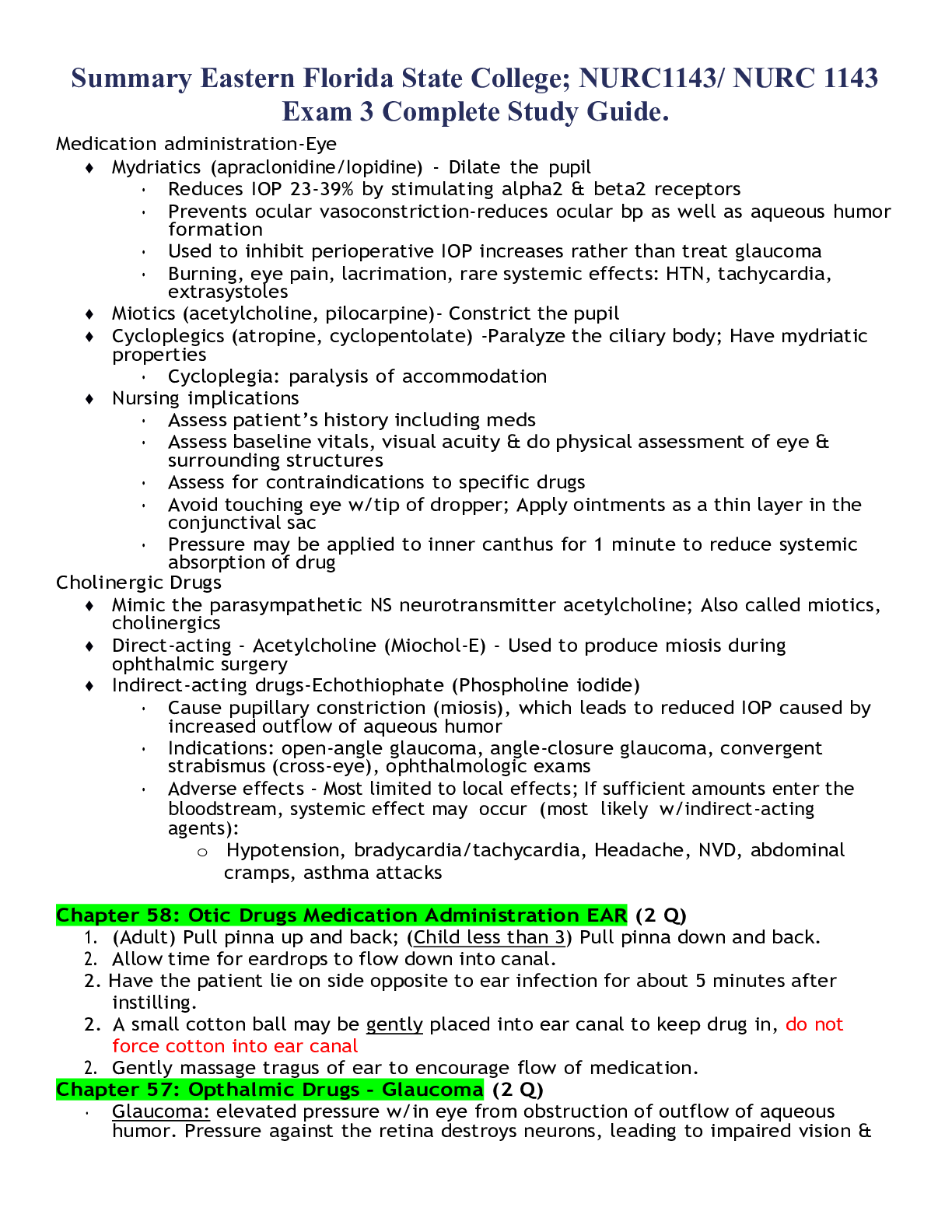
Buy this document to get the full access instantly
Instant Download Access after purchase
Buy NowInstant download
We Accept:

Reviews( 0 )
$15.00
Can't find what you want? Try our AI powered Search
Document information
Connected school, study & course
About the document
Uploaded On
Dec 02, 2021
Number of pages
30
Written in
Additional information
This document has been written for:
Uploaded
Dec 02, 2021
Downloads
0
Views
122





